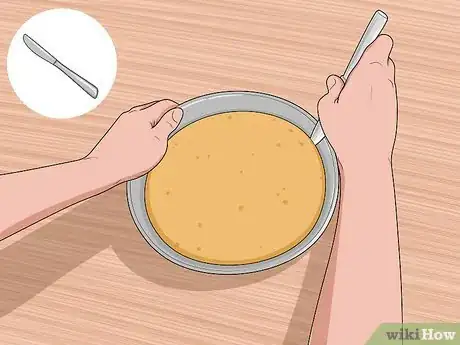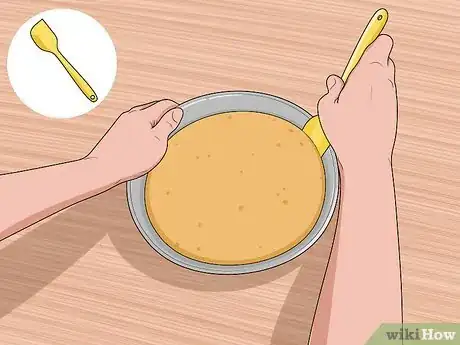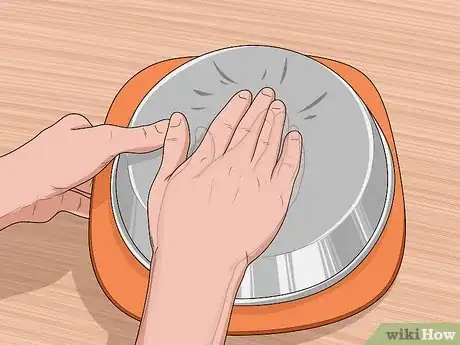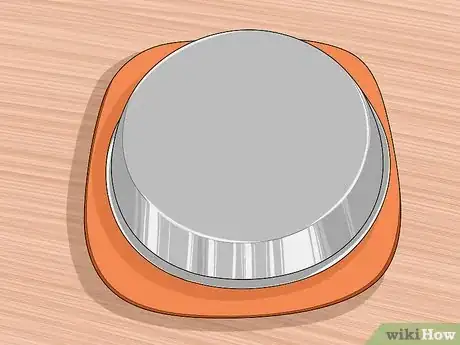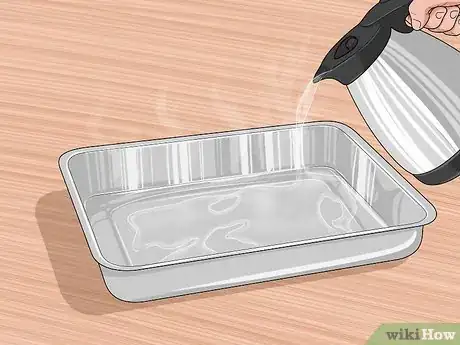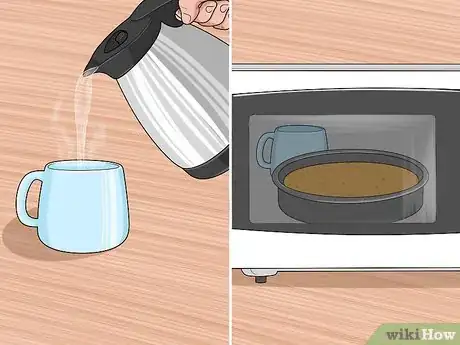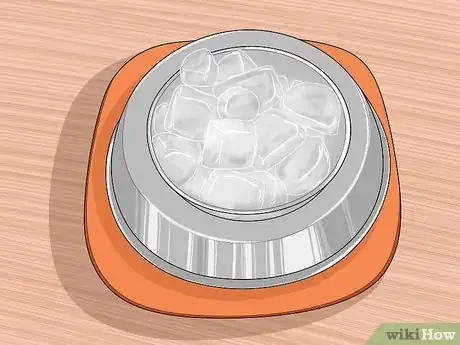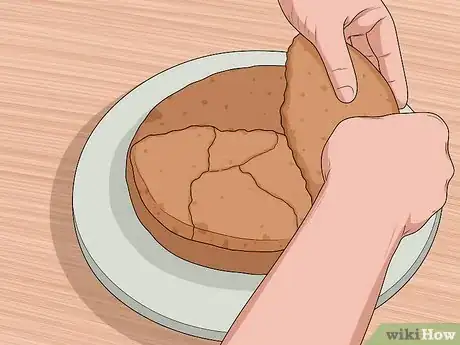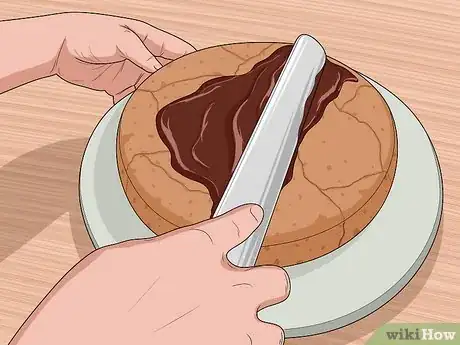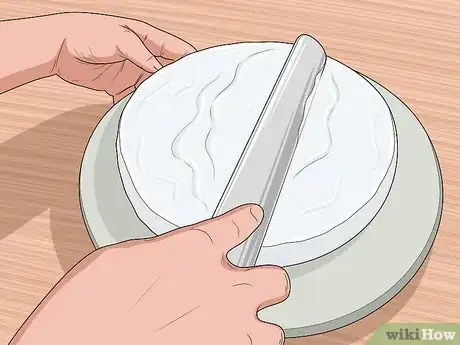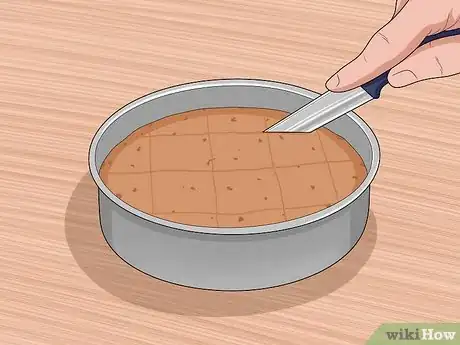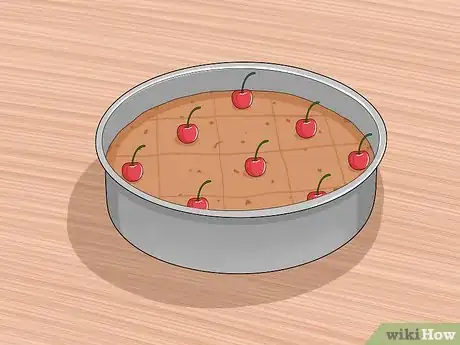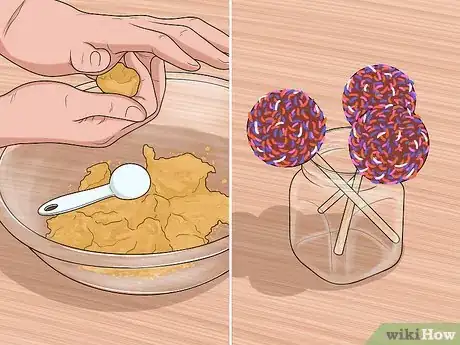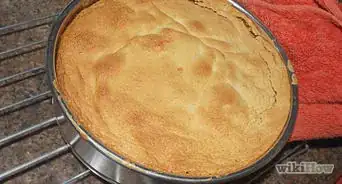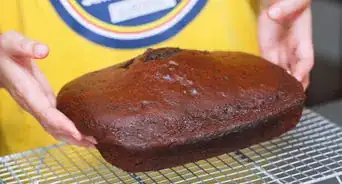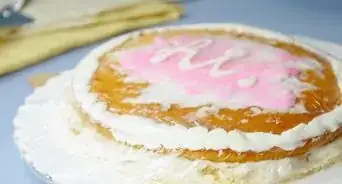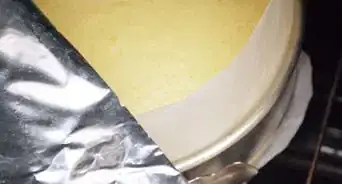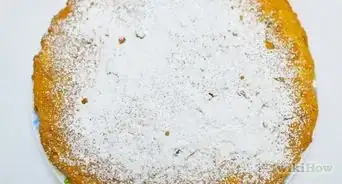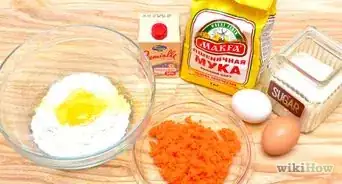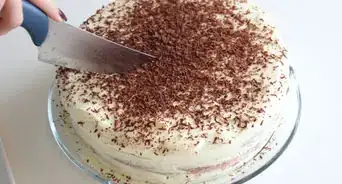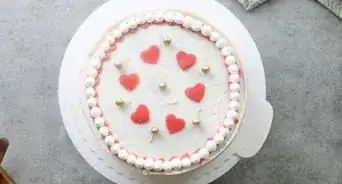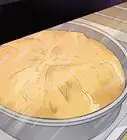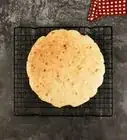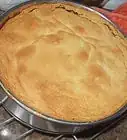This article was co-authored by Quynh La. Quynh La is a Professional Baker and the Owner of Sugar Bakery & Cafe in Seattle, Washington. With over seven years of experience, she specializes in baking cakes, cookies, croissants, and bread. Quynh holds an AAS in Culinary Arts from South Seattle College and a second AAS in Specialty Desserts & Bread from Seattle Central College.
This article has been viewed 246,659 times.
Unless you use a high-fat recipe or line your cake tin in advance, your cake will stick anywhere it touches the pan. A little prying and patience will often solve the problem, but you can resort to other methods for an especially stuck cake.
Steps
Prying Out the Cake
-
1Pry the sides loose with a rounded knife.[1] Select a palette knife if you have one, or a slim butter knife if you don't. Push the vertical knife down between the cake edge and the pan. Carefully move the knife around the entire cake to loosen the sides. Stay as close to the pan edge as possible to minimize the amount you cut into your cake.
- If the cake is for a major occasion, you may want to try the other methods first. This one often causes minor damage.
- If the cake burned onto the sides, saw up and down slowly to break it loose. You may need to go around the cake four or five times.
-
2Unstick the bottom with a flexible nylon spatula. Push the spatula down at the edge of the pan, as you did with the knife.[2] This time, lever the spatula inward as you move around the cake. This tool should be flexible enough to separate the perimeter of the base from the pan.
- If the cake is seriously stuck, don't try to force it off. Skip down to one of the other methods instead.
- You can use a thin metal spatula or pizza peel instead. Run hot water over it first, as the heat and moisture can help unstick the cake.
Advertisement -
3Shake the cake onto the serving plate. Place a large plate over the cake pan. Hold them firmly together and flip them upside down.[3] Shake the pan softly until the cake comes out.
- You may flip it onto a cooling rack instead. Keep something underneath the rack to catch crumbs.
- If the cake is damaged, skip down to the cake repair instructions.
-
4Tap the base of the pan. Knocking the base of the pan can dislodge the cake. Hold the cake just above the plate when trying this, tilted at a 45º angle. If this still doesn't work, turn the pan right side up and bash the side against a countertop.
-
5Leave it to sit upside down. If the cake still hasn't popped out, it might do so once the pan is fully cooled. Leave it upside down over the serving plate and cross your fingers.
-
6Twist or lever the cake out (not recommended). In most cases, you should try one of the methods below instead. If you don't have the time or tools to do so, you can try to remove the cake by force. Be forewarned: this usually results in a broken cake.
- Hold the cake with your hands or a spatula, while twisting the pan.
- and/or Lever the cake out using the same rounded knife. This time, angle the knife inward toward the center of the cake to break off the base.
Using Heat, Steam, or Cold
-
1Pour hot water in a deep tray.[4] The tray should be wide enough to hold your cake pan. Pour in a shallow ¼" (6mm) layer of hot tap water.
- If you don't have a tray this size, soak a dishcloth in hot water and wrap it around the base of the pan.
-
2Sit the cake pan in the tray of water.[5] The heat will cause the metal pan to expand slightly, pulling away from the cake edges. Leave it there for a few minutes to let this happen. Attempt to remove the cake as described above.
-
3Steam out the cake. Absorbing steam add moisture and "lift" to your cake, which can help it become unstuck. Boil water in a small saucepan or kettle, then pour it into a mug. Place the mug and the cake pan in a microwave, cupboard, or other enclosed space. Leave it there for several minutes, then try to remove the cake again.
- The microwave is just a convenient size for trapping the steam in with the cake. Do not turn it on.
-
4Place ice on the base of the pan. Turn the pan upside down over a serving plate. Place a bowl of ice on the pan base and leave it for several minutes. Attempt to remove the cake as before.
-
5Freeze the cake solid. Let the cake cool completely at room temperature, about one hour. Freeze the cake for six hours. This makes it harder to ruin the cake's shape, and may break it loose from the pan. Run a butter knife around the edge to separate the sides, even if you already did this before freezing. Hold the pan upside down and tap the base to see if it worked.
Fixing a Damaged Cake
-
1Cut off the burned layer. If the cake is burned, carefully saw it off with a wire cake cutter or a large bread knife. If it ends up crooked, don't try to fix it with a second cut, as this will likely reduce your cake to crumbs. Patch the broken area with frosting instead, as described below.
-
2Add small broken pieces to the bottom of the cake. If a few small bits have broken off, wedge them underneath the cake. If your cake is moist enough, these will stick back to the cake fairly well, especially if the cake is still hot.
-
3Cover minor damage with frosting. Put together a batch of frosting and spread it over the cake in a smooth surface. Dollops of any frosting can fill holes and uneven edges in a cake.
- Sugar-and-liquid icing is too thin and runny to do the trick.
-
4Piece together broken cake with gluey frosting. If your cake looks like a demolition site, you'll need extra-sticky frosting to hold it together. You can make caramel frosting, dulce de leche, or try this sticky chocolate frosting recipe:
- Mix 1 can condensed milk, 3 tsp (15mL) cocoa powder, and 2 tsp (10g) unsalted butter.
- Cook over medium heat, stirring constantly. Stop when it reaches a slightly thick, gluey consistency.
- Allow it to cool to room temperature; it will thicken more as it sets.
- Place the broken pieces on top of each other as close to the desired shape as possible. Cover the surface and cracks liberally with the frosting.
Saving a Completely Stuck Cake
-
1Cut the cake into squares. Cut a grid of squares in the cake pan — even if it's a round cake. Use a wide, flexible spatula to carefully separate the square pieces from the base.
- Keep reading to find uses for the stuck pieces at the edge.
-
2Serve in the pan. The easiest option is to frost and serve the cake in the pan. The slices will break apart during serving, but it will look attractive on the table.
-
3Make cake pops. If you've torn the cake into pieces trying to get it out, change your plans and put together some cake pops. You can read these detailed instructions, or try the simple (and sometimes sloppy) recipe:
- Rub together the chunks of cake in a large bowl.
- Beat in cream cheese or buttercream until the mixture reaches a doughy consistency.
- Roll the largest chunks into balls.
- Dip in chocolate sauce, then sprinkles (optional).
Community Q&A
-
QuestionWhen I was removing my half-sheet cake from the pan, it split in the middle. Can I use it, since it was going to be a double layer cake?
 Community AnswerUse frosting to stick it together, and keep going like normal.
Community AnswerUse frosting to stick it together, and keep going like normal. -
QuestionI've added 1 tablespoon baking soda instead of baking powder. The cake burnt totally in just 15 minutes; can I salvage it?
 Community AnswerProbably not. If it's burnt deeper than just the crust, and on top as well, there is very little you can do. Also, keep in mind that changing the ingredients of a cake will change the consistency, which will change the cake overall.
Community AnswerProbably not. If it's burnt deeper than just the crust, and on top as well, there is very little you can do. Also, keep in mind that changing the ingredients of a cake will change the consistency, which will change the cake overall. -
QuestionOne of my layers was stuck in the middle of the pan after cooling. I was able to scrape off the area without it breaking. How do I glue it in?
 Niah BrownCommunity AnswerBefore putting the cake batter in the pan, try buttering the pan. Use butter spray or normal butter and spread or spray the whole pan before putting in the cake batter.
Niah BrownCommunity AnswerBefore putting the cake batter in the pan, try buttering the pan. Use butter spray or normal butter and spread or spray the whole pan before putting in the cake batter.
Things You'll Need
- Palette knife or butter knife
- Flexible nylon spatula, thin metal spatula, or pizza peel
- Tray
- Warm water
- Dishcloth
References
- ↑ Quynh La. Professional Baker. Expert Interview. 11 March 2022.
- ↑ Quynh La. Professional Baker. Expert Interview. 11 March 2022.
- ↑ Quynh La. Professional Baker. Expert Interview. 11 March 2022.
- ↑ Quynh La. Professional Baker. Expert Interview. 11 March 2022.
- ↑ Quynh La. Professional Baker. Expert Interview. 11 March 2022.
About This Article
If your cake is stuck to your pan, you can easily fix it by prying the sides of the cake loose with a butter knife and sliding a flexible spatula under the cake to pry the bottom free. Then, flip the cake over and shake it onto a serving plate, tapping the bottom of the pan if necessary. If the cake still doesn’t come out, leave it upside down until the pan is fully cool and it may come out on its own. You can also freeze the cake for 6 hours to break it loose before trying to pry it free. To learn how to repair a damaged cake, read more!
